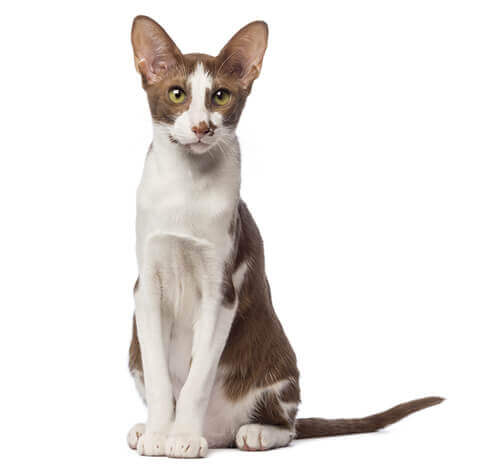
The Oriental is a sleek, elegant cat with large, flaring ears and almond-shaped eyes. A playful, spirited breed, the Oriental has a vivacious personality. This people-oriented feline usually forms a close bond with one person. Those who give an Oriental the affection she needs will find she does anything to please them. This is a healthy breed that can live for 15 years or longer.
DID YOU KNOW? Originating in the 1950s, the Oriental was selectively bred from Siamese. The breed has two coat varieties, shorthair and longhair, both of which can appear in litters. The Oriental longhair actually has a medium-length coat and is considered rare.
The need-to-know
- Highly active and inquisitive cat
- Sociable and dependent cat
- Very talkative cat
- Lean and elegant cat breed
- Requires grooming once a week
- Outdoor cat
- May require familiarisation before living with children
Personality

Like the Siamese, the Oriental cat breed is an intelligent, curious cat that makes its presence known. They love to talk to their human companions and expect a reply. They want to be part of the family and enjoy playing games like fetch with a ball of scrunched up paper. Oriental cats like to be kept amused and do not like to be left alone, so if you are out at work all day, getting another Oriental cat is probably a good idea.
History and Origins

Country of Origin: USA/Britain
The Oriental cat is really a Siamese with a different colour coat and green eyes (except in the case of the Foreign White which has blue eyes). The shape and temperament are exactly the same as the Siamese. The Oriental cat breed was created by crossing Siamese cats with other breeds to produce different colours. Black 'Siamese' had been in existence for a long time but it wasn't until the 1950s that serious efforts were made to breed different colours and the black form is known as the Black Oriental cat. The next Oriental breed to be developed was the Havana, a chocolate colour 'Siamese' (not to be confused with the Havana Brown which is a separate American breed). Selective breeding has since produced many more colours and coat patterns.
Nutrition and Feeding

Every cat is unique and each has their own particular likes, dislikes, and needs when it comes to food. However, cats are carnivores and every cat must obtain 41 different and specific nutrients from their food. The proportion of these nutrients will vary depending on age, lifestyle and overall health, so it's not surprising that a growing, energetic kitten needs a different balance of nutrients in her diet than a less active senior cat. Other considerations to bear in mind are feeding the right quantity of food to maintain 'ideal body condition' in accordance with feeding guidelines and catering to individual preference regarding wet or dry food recipes.
Other Information

Health and common issues
Oriental cats can live well into their teens. Although most Oriental Longhair cats live long and healthy lives, there are a number of disorders that seem to be associated with the Oriental cat family - those similar to the Siamese as they are closely related.
Best cat breeds for children
While this breed is not widely recognised as one of the best breeds for children, all cats are different and with the proper familiarisation may still be able to live with children.